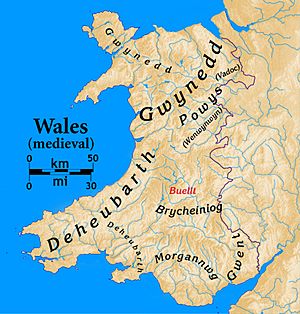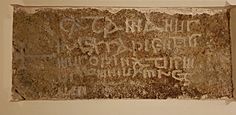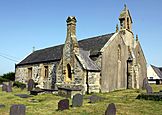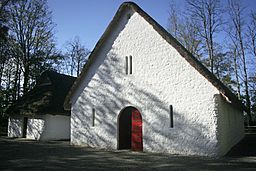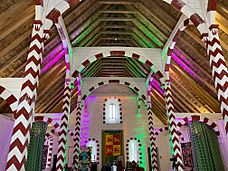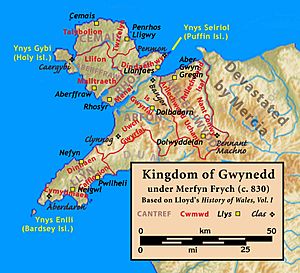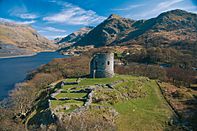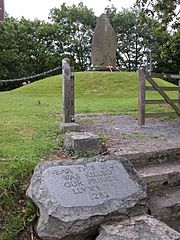House of Aberffraw facts for kids
| House of Aberffraw |
|||
|---|---|---|---|
Quick facts for kids 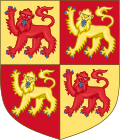 Traditional Arms of the Aberffraw House of Gwynedd |
|||
| Country: | Wales | ||
| Parent House: | House of Gwynedd | ||
| Titles: |
|
||
| Founder: |
|
||
| Final Ruler: | Dafydd III | ||
| Current Head: |
List
Disputed since 2022:
|
||
| Founding Year: | c. 390 | ||
The Royal House of Aberffraw (Welsh: Talaeth Aberffraw) was a very important family in the medieval Kingdom of Gwynedd in Wales. This royal family started in the 9th century with Rhodri the Great. He built a Palace at Aberffraw and named his oldest son, Anarawd ap Rhodri, as the heir to the King of Wales.
Bringing back a royal court (called a Llys) at Aberffraw on Anglesey island in North Wales was a big step for Welsh royalty. This area used to be a royal land. The Aberffraw family members held important titles like King of Wales, King or Prince of Gwynedd, and later Prince of Wales. They were also sometimes called the Lords of Aberffraw, Anglesey, and Eryri.
Scientists have found proof that people lived at the Aberffraw royal court from the 1st to the 4th century AD. This shows there was a settlement there even before, during, and after the Roman conquest of Anglesey. When the Romans came, they brought Christianity. St Beuno's Church was built in the 12th century and is still used today. Before the Romans, the Celtic people of Wales followed Pagan religions and had Druid priests.
The Aberffraw Palace (Llys) was used by the Welsh Royal family for almost 400 years, from the 9th to the 13th centuries. It was the capital of Wales for some of that time. In 1283, the last named heir, Dafydd ap Gruffydd (Dafydd III), broke away from Edward I of England. Dafydd III was later found guilty of treason (betraying his ruler). After this, there were no more direct heirs to rule the Principality of Wales. Over a century later, the main male line of the Aberffraw family ended when Owain Lawgoch died without children in 1378.
When people talk about "Aberffraw," they are usually referring to this royal family branch. Historians use this term to show the clear line of rulers from Rhodri the Great through his oldest son, Anarawd.
Contents
- Roman Rule in Britain
- The Royal Court (Llys)
- Starting the Aberffraw Family (873)
- Viking Raids (850s-1100s)
- Welsh Power and Norman Invasion
- Welsh Castles and Expansion
- Welsh Principality: Prince of Wales (Welsh Rule, 1216–1283)
- End of the Dynasty and Its Impact
- After the Dynasty Ended
- Biographical Sources Online
Roman Rule in Britain
The Roman conquest of Britain started in 55 BC and ended in 410 AD. During this time, Celtic kingdoms were set up across Great Britain. Celtic tribes fought against the Roman invasions for over 100 years. A big change happened in 52 AD when tribal leaders gave up to the Roman Emperor, Claudius. Britain (called Britannia) was then split into four areas ruled by Roman governors.
During Roman rule in Wales, Anglesey was invaded twice. The first time was around 60/61 AD. The Welsh Celtic Ordovices tribe, who were Druids, were defeated by Gaius Suetonius Paulinus and his Roman forces. This happened at Castell Bryn Gwyn, a hillfort near Llanidan. Later, the Welsh Ordovices tribe attacked and almost destroyed the Roman cavalry in North Wales.
Anglesey was invaded again in 77 AD by the Roman Governor Gnaeus Julius Agricola and the XX Legion. They defeated the Ordovices tribe in 78 AD.
At the old Aberffraw Palace site on Anglesey, there was a settlement during the Roman period. Pieces of Roman pottery found there date from 27 to 387 AD. The Aberffraw Llys was dug up by archaeologists in the 1970s and 1980s. The palace site had been used for thousands of years before AD, from prehistoric times until 1317.
Welsh Kingdoms After the Romans
After the Romans left around 400 AD, the old tribal areas of Wales changed. Wales was divided into four kingdoms: Kingdom of Gwynedd (north), Kingdom of Powys (east), Kingdom of Gwent (south), and Kingdom of Deheubarth (west). Of these, Gwynedd's settlement of Aberffraw on Anglesey was the main home for the Princes of Wales.
The Welsh Royal Family of Aberffraw came from the time after the Romans left Britain. Their ancestor was King Cunedda (born in the 380s), who founded the Kings of Gwynedd. Cunedda was a Roman soldier who came from Scotland to Gwynedd in 401. His grandson, Cadwallon Lawhir ap Einion (around 443 AD), set up a home on Anglesey. He also helped push back the Irish Celts who had invaded the island.
Christianity in Anglesey After the Romans
After the Romans left Britain, many Roman roads and forts were built. Churches were also started. Some of the original Roman religious places were still used after the Romans left. Many lasted until the 6th century. For example, the Romans built a military outpost on Anglesey near Aberffraw, at Holyhead. This fort, Caer Gybi, was later given to Saint Cybi. He turned it into a church in the 6th century. St Cybi's Church has been changed many times but is still used today.
Christianity came to Britain in the 3rd century. After the 6th century, new churches were built across England and Wales. Some of these churches are still standing today. Wales' special saint is Saint David (died 589). By the 7th century, Cadwallon ap Cadfan, who was King of Britain and Gwynedd, became a monk. He lived at a monastery that is now St Cadwaladr's Church in the village of Llangadwaladr. This church is less than a mile from Aberffraw.
His son, Cadwaladr, gave up his title as the last King of Britain (Welsh: Brenin y Brythoniaid). He moved to France and died in Rome in 703. Cadwallon's father, Cadfan ap Iago (died 625), has a tombstone still in the church. The Catamanus Stone on the north wall of the church says, "King Cadfan, the Wisest and Most Renowned of All Kings." Around 620 AD, Cadwallon moved the royal court of Gwynedd from Aberffraw to Caernarfon. This was because Picts from Ireland had taken over Anglesey.
Aberffraw's church, St. Bueno's, is named after the Welsh Saint Beuno Gasulsych (died 642). Beuno lived at the same time as King Cadfan ap Iago. The church building we see today was first built in the 12th century. It was made bigger in the 16th century and changed again in the 1840s. It is still used today. The church is the main old building in the village, located at the mouth of the river Afon Ffraw.
The Royal Court (Llys)
Aberffraw Llys served as the capital of the Kingdom of Gwynedd. The Princes lived and hosted guests at their royal courts. They usually had a favorite palace as their main base. However, the court would often move from one place to another. Many of these old court sites are now unknown, replaced by farms or villages after Edward I of England conquered Wales in 1277.
The Aberffraw Royal Court was on Anglesey. Other local royal courts (called Llysoedd) were at Llys Llanfaes, Cae Llys Rhosyr, Caer Gybi, Cemaes, Talebolyon, and Penrhos. The Lords of Aberffraw were also Princes of Gwynedd. They would travel across the Menai Strait to mainland Wales, often to Snowdonia, to do their court duties and entertain important visitors. In Gwynedd and nearby areas, the royal court would visit castles and other courts that were important to the Kingdom and its friends.
These places included Llys Caer Segont (the old Roman fort of Segontium); Cantref Arfon, where Caernarfon castle was built; Dolbadarn castle; Llys Dinorwig; Llys Aber (Garth Celyn), now called Pen y Bryn in Abergwyngregyn, which became the capital of Gwynedd after Aberffraw and was the home of Llywelyn ap Gruffudd; Deganwy castle; Llys Rhun, Caer-Rhun (an old Roman fort); Trefriw; Bodysgallen; Rhos; and Rhuddlan.
The Aberffraw Palace (Llys)
Around 1200, Prince Llywelyn the Great continued to hold his Royal court at Aberffraw. He kept it to the same high standards as the English Kingdom next door. The Prince's wife was Joan, Lady of Wales, who was the daughter of King John, King of England. She would have hosted royal guests from Wales and England at Aberffraw. Llywelyn updated the rules for the 'royal suite' at the Aberffraw Royal Palace. These rules were based on old laws from 914. The palace was known as "the chief house of the Prince of Gwynedd" from when it was first built by Rhodri the Great.
The royal court had many different jobs, with at least 47 positions needed every day. Some jobs needed more than one person. This grand setup was similar to the royal households in England today. The hall at Aberffraw Palace would have been small. It was likely about 15 feet wide and 40 feet long, similar to Llywelyn ap Gruffudd's room in Harlech Castle. The Aberffraw Palace (Llys) was taken apart in 1317. Its wooden hall was moved from Anglesey across the Menai Strait to Caernarfon castle for the Kings of England.
Starting the Aberffraw Family (873)
Centuries after the Romans left Britain, Merfyn Frych (around 825 AD) became King of Gwynedd on Anglesey. He also inherited nearby kingdoms. These lands came from the last direct male family members of Cunedda Wledig, the first King of Gwynedd. Merfyn Frych's mother, Ethyllt (a Gwynedd Princess), married Gwriad ap Elidyr, the King of Isle of Man.
The Royal House of Aberffraw appeared centuries after Gwynedd was founded. This family started during a time in the 9th century when Saxons were attacking many parts of the British Isles. The Royal House of Aberffraw began with the family of Rhodri the Great. Rhodri was a son of Merfyn Frych of Gwynedd and a descendant of Cunedda. He held the title of King of Wales.
In the 9th century, Rhodri the Great inherited Gwynedd from his father and Powys from his mother. He then gained Seisyllwg (which included Ceredigion and Carmarthenshire) by marrying Angharad of Seisyllwg. In 873, Rhodri decided to move the Kingdom's main royal court back to the Aberffraw area on Anglesey. It had been away at Caernarfon for 250 years. This location was chosen to build the Welsh Royal family palace. His descendants would rule Wales and the British Isles from this new royal court. Rhodri was one of the first to be called the King of Wales (Welsh: Brenin Cymru). Before Rhodri Mawr, his ancestor Cynan Dindaethwy lived at a court on the other side of Anglesey, in Llanfaes.
Welsh Royal Families
The Welsh Royal family (around 870s) was divided into three separate Royal Houses (Welsh: y Tair Talaith). These royal houses were started by the sons of Rhodri the Great. He used a Welsh custom called gavelkind to share his lands. New family branches appeared in the 9th century. This division of land among brothers shaped Wales and led to the different Royal Houses.
Anarawd ap Rhodri (Rhodri's oldest son) started the House of Aberffraw on the Isle of Anglesey (Welsh: Ynys Môn) in 877. He made Aberffraw his main family home in the Kingdom of Gwynedd (North Wales). Rhodri's second son, Cadell ap Rhodri, started the House of Dinefwr in the Kingdom of Deheubarth (South Wales). His third son started the House of Mathrafal in the Kingdom of Powys (Mid Wales). Of the three, Aberffraw was seen as the most important family in Wales. These 'Three Crowned Princes' were called 'Tri Tywysog Talaethog' in Welsh.
Succession Rules
Deciding who would be the next ruler in the House of Aberffraw was complicated because of special Welsh law. Normally, the oldest son was expected to inherit the father's position and title as "head of the family." This was similar to primogeniture, where the oldest son gets everything. However, all sons were given land from their father. Sometimes, daughters also received land. Men could also claim royal titles through their mother's family in certain situations. The female side of the family was also considered royal. Marriage was important for making claims to Welsh kingdoms stronger and for bringing families back together after civil wars.
Laws of Hywel
Around 945 AD, Rhodri's grandson, Hywel Dda, wrote down laws for the Kingdoms of Wales. These laws, called the Cyfraith Hywel (English: laws of Howel), shaped Welsh society. They included rules for family succession, explaining how Welsh Kingdoms would choose their heir based on the gavelkind system. This meant that only direct male descendants could inherit titles and lands from their family ancestors.
Viking Raids (850s-1100s)
During the time of the Welsh-Norse era (850s-1100s), Viking raids happened all over Wales between 852 and 919. For example, a Viking leader named Ingimund was forced out of Dublin. He tried to set up a base on Anglesey around 902 but failed and went to Chester instead.
The Welsh Kingdoms had been under the control of the Kingdom of Mercia (in England) since the 7th century. This led to the building of Offa's Dyke, a border wall between England and Wales, in the late 8th century. However, wars broke out against the English from 853 to 892. This ended with a victory for the Welsh Kingdoms of Gwynedd and Powys against the English Mercian and Wessex Kingdoms, who had help from Anglo-Saxons and Danes.
After winning battles against the Vikings (Anglo-Saxons and Danes), starting with the death of 'Horn the Dane' in 856, Rhodri the Great was killed in battle against the Saxon leader Ceowulf of Mercia in 878 AD. But the Welsh got revenge for their King with a victory over the English Mercians at the Battle of the Conwy in 881. During this time, Rhodri Mawr's sons relied on Viking soldiers for protection.
The second wave of Viking raids in Wales continued into the 10th century. Between 950 and 998, Wales saw many raids and slave raids. A very bad Viking raid happened at Aberffraw in 968. King Maredudd ab Owain had to pay money to get Welsh people back who had been captured. The third wave of Viking raids happened at the same time as the Norman invasion of Wales in the 11th century.
This era saw a new friendship between the Vikings and Aberffraw. Gruffudd ap Cynan's father, Cynan ab Iago, married the daughter of a Norseman after he found safety in the Kingdom of Dublin. After trying many times to take Gwynedd back from the Normans, Gruffudd finally succeeded. He got help from Magnus Barefoot (King of Dublin, Norway, and the Isles) in 1098. Together, they won the Battle of Anglesey Sound against the English Normans.
Welsh Power and Norman Invasion
The Aberffraw family was strong in Gwynedd, their main area. But by the 11th century, they were pushed out of Powys (Mid Wales) and Deheubarth (West Wales) by their younger relatives from the House of Dinefwr. However, under Gruffudd ap Cynan, Aberffraw was able to get back his lands and his position as Prince of Gwynedd from Norman invaders by 1100.
Owain Gwynedd, Gruffudd ap Cynan's son, defeated King Henry II of England and his large army in 1157 and 1166. This led to Owain being called The Prince of the Welsh (Template:Medieval Latin: Princeps Wallensium) by other Welsh rulers. This showed that the Aberffraw family was still the main royal family of Wales, as they were the oldest descendants of Rhodri the Great. This was also written in a 12th-century book called The History of Gruffydd ap Cynan. This book was written in Latin and was probably for people outside Wales. Historian John Davies wrote that this claim meant the Aberffraw family did not owe anything to the English king for their power in Wales. They held authority "by absolute right through descent."
Important members of the House of Aberffraw included Idwal Foel, Iago ab Idwal, Cynan ab Iago, Gruffudd ap Cynan, Owain Gwynedd, Gwenllian ferch Gruffydd, Llywelyn the Great, Llywelyn ap Gruffudd, Dafydd ap Gruffydd, Madog ap Llywelyn, and Owain Lawgoch.
Aberffraw Dynasty: Kings, Princes, and Lords
The Aberffraw family was a senior royal line. They were considered the King of Wales, and also Kings and Princes of Gwynedd. These titles often came from conflicts during the Anglo-Welsh wars. Aberffraw became a main home for the Princes of Gwynedd in Wales in the High Middle Ages.
Llys Aberffraw was a strong base for the most successful warlords in Welsh history. They conquered all of Wales and fought against the English. For example, the signing of the Magna Carta helped Llywelyn the Great, who was the first official Prince of Wales. Their titles like 'Prince of Aberffraw' and 'Lord of Snowdon' were recognized by the English Crown. The Prince of Gwynedd would receive gold payments from his people. This was a golden age during the rule of Llywelyn ab Iorwerth, who was recognized as the ruler of all of Wales.
The 12th-century poet Llywarch ap Llywelyn called Dafydd ab Owain Gwynedd, a son of Owain Gwynedd, 'Lord of Aberffraw' and the 'inherent chief ruler' of all of Wales. Dafydd had married Emma of Anjou, who was King Henry II of England's half-sister. Llywarch also wrote 9 poems about Llywelyn the Great.
The Aberffraw family started a new era for the Welsh people in Gwynedd. This began with Gruffudd ap Cynan, whose mother was the daughter of the Irish / Hiberno-Norse King of Dublin, Olaf Sigtryggsson. Having a non-Welsh Princess showed another new beginning for Aberffraw. Gruffudd's son Owain Gwynedd saw the family fall into civil war for decades in the 12th century. These wars were not just in Wales but all over the British Isles, due to the Norman Conquest and the Angevin period.
Generations after Cynan, Llywelyn Ab Iorwerth (the Great) married Joan, Lady of Wales, the daughter of John, King of England. King John was from the Duchy of Normandy in France and was a descendant of Charlemagne, the 'Emperor of Europe'.
Aberffraw Senior Line Family Tree
Here is a family tree of the Aberffraw dynasty of Gwynedd, from around the 1000s to the 1200s:
- Gruffudd ap Cynan (c. 1055–1137), Prince of Gwynedd.
- Owain Gwynedd (c. 1100 – 28 November 1170), Prince of the Welsh, Prince of Gwynedd
Married Cristina ferch Gronw ap Owain ap Edwin.- Hywel ab Owain Gwynedd
- Caswallon ap Hywel
- Iorwerth ab Owain (Iorwerth Drwyndwn) (1145–1174).
- Llywelyn ab Iorwerth (Llywelyn the Great, c. 1173 – 11 April 1240), Prince of Wales, Prince of Gwynedd and Powys, Prince of Aberffraw and Lord of Snowdon.
- Rhodri ab Owain Gwynedd (c. 1146–1195), Lord of Anglesey
Married Annest ferch Rhys ap Gruffudd.
- Hywel ab Owain Gwynedd
- Owain Gwynedd (c. 1100 – 28 November 1170), Prince of the Welsh, Prince of Gwynedd
Welsh Castles and Expansion
Early castles in Wales were built with wood and did not last long. Some of these forts were built on existing hillforts, using the natural hills for defense. Others were motte and bailey castles, which had a mound and a walled area. After the Norman invasion of Wales in the 1080s, Norman castles like Aberlleiniog castle on Anglesey were built in Gwynedd.
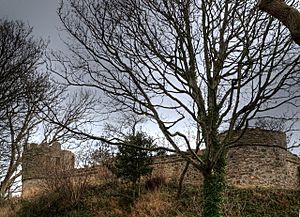
Later, a new era of castle building began with the "ring of iron" (1277-1320s). These castles were designed by a European master mason, James of Saint George, who worked for Edward I. The building project included Beaumaris Castle, which was never finished due to lack of money. Beaumaris was built to protect English interests on Anglesey. It was a direct response to the rebellion of Madog ap Llywelyn (a distant Aberffraw family member) in 1294–95.
The Kingdom of Wales survived Anglo-Saxon invasions and Viking raids. But eventually, the Normans took over, starting with Hugh d'Avranches, Earl of Chester in 1086. Aberffraw Palace was then left empty, and its roof fell in. However, it must have been rebuilt, as Llywelyn ab Iorwerth (Llywelyn The Great) used a palace there. This building was later taken apart around 1317. Besides the later palace, there was also a wooden structure and a mound for a castle-like fort.
To fight back against the invasion, the Welsh Princes of Wales used their alliances with other Welsh Kingdoms. They also used the building knowledge of the Normans and English. They built many castles across North Wales. Over 400 castles were built in Wales, but only about 10% were built and lived in by Welshmen. When stone castles became common in Wales in the 11th century, they did not replace the original Welsh courts (Llys). Most new castles were built to protect important roads and allow for cattle farming. Welsh castles were usually built in places with strong natural defenses, like hilltops or next to rivers.
It wasn't until Prince Llywelyn the Great's rule that stone castles were successfully built. During his reign, King Edward I of England blocked grain shipments meant to feed Llywelyn's army from leaving Anglesey.
During the Norman castle-building period (1088-1277), most native Welsh strongholds were built for the Aberffraw family. Llywelyn the Great oversaw the building of stone castles in Gwynedd, but these castles were expensive. Their locations were chosen for military reasons and for animal grazing around Snowdonia. Most Welsh-made castles were built because of the invasion by Llywelyn's father-in-law, King John of England, and as a response to the Welsh uprising of 1211. By 1271, Prince Llywelyn II ruled about 200,000 people, which was about three-quarters of the total Welsh population.
Norman-Built Castles
The 11th-century Norman invasion brought new castle building and warfare to Wales. Normans fought invaders, and sometimes the Welsh fought among themselves over who would rule next. Norman-built castles like Gaer Penrhôs and Mold Castle were invaded by Gruffudd ap Cynan's sons and taken over by the Welsh. The Welsh then built new castles on these Norman sites. Mold Castle changed hands five times between Welsh and English control during the 12th and 13th centuries. Often, Norman castles were destroyed and rebuilt when the Welsh took them over.
Through rebellions and battles, members of the House of Aberffraw used Norman estates as their homes. The Norman castle in Aberlleiniog, Anglesey, was used by Aberffraw Princes, even though the Earl of Chester built it in 1088. Another example was Aberystwyth Castle. This Norman stone castle was built and lived in by the Norman Lord of Ceredigion, Gilbert De Clare.
Owain Gwynedd and his brother Cadwaladr ap Gruffydd captured Aberystwyth Castle in 1121. They invaded Norman-controlled Ceredigion and took five castles there before the Normans were defeated by Welsh forces at the battle of Crug Mawr a decade later. Aberystwyth was destroyed and later rebuilt by Llywelyn the Great. Then, King Edward I took it back and rebuilt it again. In 1136, after Crug Mawr, Gwynedd and his brother took Cardigan Castle. They drove out the French and Flemish people who lived there and took their treasures and prisoners.
Even though Owain's rule was sometimes harsh, he continued his father's fight against the English Crown. Many writers, like Gerald of Wales, praised his rule in Wales. His successful battles meant Wales kept its independent status. Owain became the first King of Gwynedd to be called a Prince, as agreed by Henry II of England. He is also seen as one of the first Princes of Wales because of how much land he controlled. He was one of the first Welsh leaders seen not just as a tribal chief, but as a powerful lord in Britain. Owain's sons were the first to build stone castles in Gwynedd.
Llywelyn the Great's Campaign, 1215
During the rule of Llywelyn the Great, he started a rebellion against his father-in-law, the King of England. He took control of several Norman castles in Wales in 1215. These included Carmarthen, Kidwelly, Llanstephan, and Cardigan. Trefdraeth castle was given to him by the family of Cemaes on Anglesey. Cilgerran castle was also given to Llywelyn that year. By the end of his campaign around Wales, he also gained Senghenydd castle, St. Clare, and Laugharne. By 1218, the new King, Henry III of England, confirmed Llywelyn's ownership of these castles. Other castles taken by the Welsh from Norman control in the 13th century included Newport, Loughor, Llandovery, Newcastle, Hawarden, and Morlais. Carndochan was possibly built by Llywelyn the Great.
Welsh-Built Castles
By the 13th century, the Princes of Gwynedd and members of the House of Aberffraw were called Princes of Wales. They were the first to build castles all over Wales. The only castles built by the Aberffraw family that are still standing today are Dolbadarn and Dolwyddelan. Criccieth Castle and Bere castle are partly intact. These castles were built in 1221 by Llywelyn the Great, who built more Welsh castles than anyone else.
Other Welsh castles were built in Gwynedd, now part of North West Wales. These include Criccieth, Tomen Castell, Deganwy, Castell Deudraeth, Carn Fadryn, Castell Pen y Garn, and Castell y Bere. All these castles (except Deganwy, first built in the 520s) were used by the House of Aberffraw and built between 1170 and 1280s, mostly between 1220 and 1230, within or near Gwynedd's borders.
Other stone castles were built by the Aberffraw family outside Gwynedd from around 1150 until the late 13th century. For example, Castell Cynfael near Tywyn was built by Cadwaladr ap Gruffydd in 1147. A century later, Ewloe (started by Llywelyn the Great) and Dolforwyn were built by Llywelyn II. His brother, Dafydd III, built Caergwrle Castle on land given to him by Edward I. These three castles were part of the Welsh Marches (border lands) on the English border within Wales.
Other important Welsh-made castles were built in the Kingdoms of Deheubarth and Powys, and some in South Wales. These castles were used by the Aberffraw family after they won battles against their neighbors, who were other Welsh Kingdoms and Norman Lords. Some castles were captured and recaptured many times over centuries. While the English preferred rectangular and round towers, the Welsh built D-shaped towers and a main tower with an enclosure. This architectural style was common in Welsh castles.
Welsh Principality: Prince of Wales (Welsh Rule, 1216–1283)
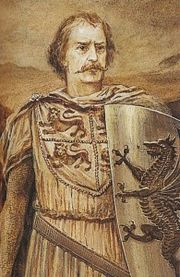
The title Prince (Welsh: Tywysog) had been used by the House of Aberffraw for several generations. First, Owain Gwynedd was given the title by King Henry II of England. Llywelyn the Great was named the Prince of Aberffraw after 1230. The title Prince of Wales was officially given by the English Crown in 1216. Llywelyn the Great received the loyalty and respect of the Dinefwr rulers of Deheubarth at the Council of Aberdyfi.
Llywelyn's influence also reached European leaders. In 1212, he made a treaty with Philip II of France. He also got help from Pope Innocent III in the Vatican, who released him from his promises to King John of England. With other Welsh lords showing him loyalty at the Council of Aberdyfi, Llywelyn the Great became the first true "Prince of Wales" in the modern sense. However, his son Dafydd ap Llywelyn was the first to actually use that title.
But the Conquest of Wales by Edward I in 1282 greatly reduced the family's power. King Edward I of England forced the remaining family members to give up their claim to the Prince of Wales title under the Statute of Rhuddlan in 1284. This law also ended the independent Welsh nobility. The Aberffraw family were heirs to the newly formed Principality of Wales. However, the family members closest to Llywelyn II were imprisoned for life by Edward I. His younger brother, Dafydd III, was killed.
Later Aberffraw Claimants
More distant Aberffraw family members went into hiding and were forgotten. Some members of the Welsh Royal family did claim the Principality of Wales and the title of Prince because of their heritage. These men included Madog ap Llywelyn (a descendant of Owain Gwynedd) in 1294–95, Llywelyn Bren (a descendant of Hywel Dda) in 1317, Owain Lawgoch in the 14th century, and Owain Glyndwr a century later. Both Owains were descendants of Prince Llywelyn the Great. Glyndwr declared himself Prince of Wales in 1400. These men all rebelled against the English who controlled Wales.
English Title
From 1301 onwards, less than a decade after the end of the House of Aberffraw, the title of Prince of Wales was given to the future King of England. This started with Edward of Caernarfon, who was an Anglo-Norman English King. His family had invaded, separated, and destroyed the Welsh Kingdoms.
Today, Prince William holds the title of Prince of Wales. He is a descendant of Llywelyn the Great through the English House of Tudor (around the 15th century). The Tudors claimed Welsh ancestry from the Tudors of Penmynydd (descendants of Ednyfed Fychan, who was like a Prime Minister to Llywelyn the Great). Prince William is also a descendant of Owain Glyndwr through marriage.
End of the Dynasty and Its Impact
From Llywelyn the Great to his great-great-grandson Owain Lawgoch, the royal house of Aberffraw ended after centuries of trouble from the Conquest of Wales by Edward I. In less than a year, between late 1282 and late 1283, the two brothers who were Princes of Wales, Llywelyn the last and Dafydd III, were killed by the English Crown.
First, Llywelyn was killed in a meeting between English and Welsh forces at the Battle of Orewin Bridge at Cilmeri on December 11th. His body was sent to the Tower of London. Then, in 1283, after rebelling against English rule in Wales, Dafydd III was forced into hiding. He had attacked several castles, including Rhuddlan and Hawarden castles. Dafydd III was then betrayed by his own men while hiding near Dolbadarn. He was put on trial for treason against the King of England and then executed in Shrewsbury. After 1283, the next Prince of Wales was Edward II of England, who was born in Caernarfon castle in Wales. He was not Welsh, but of Anglo-Norman descent.
The new era of the Principality of Wales ended the Welsh customs and laws that Hywel Dda had started in 945. The last direct male descendant of the dynasty, Owain Lawgoch, was Dafydd III's great-nephew (a descendant of Llywelyn the Great). Lawgoch's grandfather (Rhodri ap Gruffudd) gave up his rights to Gwynedd and moved to a manor in Tatsfield, Surrey. Owain then spent his childhood in England before becoming a soldier in France. He tried to plan a takeover from France to return to Wales but was killed in 1378.
Later Succession Claims
Later Welsh families, including the Wynn family of Gwydir (around the 17th century) and the Anwyl of Tywyn family (who claim to be the current head of the family, though this is disputed), claimed to be heirs of the dynasty. Both families were descendants of Owain Gwynedd.
Current Succession Debate
Today, the Head of the House of Aberffraw would officially be called the de jure Prince of Gwynedd. This royal title is still recognized by the Pope in the Vatican City and by the descendants of the former Kingdom of France. The person who leads the former Welsh Royal family would be a contender for the original, true title of Prince of Wales. This title was last held by Owain Glyndŵr in the 15th century.
Currently, the possible head of the House of Aberffraw (and also Gwynedd and Wales) is debated among six Welshmen (one is half-French), two Irish men, and one Englishman. This debate started online in 2022. It will decide who will be the next head of the former ruling family of Aberffraw. This complex decision could be made in several ways, possibly needing a court decision, based on gavelkind, male primogeniture, or other rules.
After the Dynasty Ended
The last male descendant of the Aberffraw Dynasty was Owain Lawgoch. Born less than a century after Llywelyn the Great died, his family claims ended when he died in 1378. Just a century later, the Meyrick (Welsh: Meurig) family of Bodorgan, Anglesey, was given the right to rent the manor lands of the Aberffraw cantref from the Crown.
Llewelyn Ap Heilyn fought at the Battle of Bosworth alongside Henry VII of England. Henry Tudor, as he was also known, was a descendant of the Aberffraw dynasty through the Tudors of Penmynydd. They came from Ednyfed Fychan, who was like a Prime Minister to Llywelyn the Great and his son Dafydd II. Then Heilyn's son, Meurig ap Llewelyn, became the captain of Henry VIII's bodyguards and was rewarded with the lease. Today, the same family at Bodorgan Hall (near Aberffraw) is represented by the Tapps-Gervis-Meyrick baronets.
Aberffraw Court (Llys) Today
Llys Aberffraw was similar to the nearby Llys Rhosyr (a copy of which is found in St Fagans National Museum of History). Welsh people built Llys Rhosyr after the Norman conquest of Wales. The Normans built castles like the Castles and Town Walls of King Edward in Gwynedd to control the local people. The town of Llanfaes was moved to Rhosyr from across the island, which allowed Beaumaris Castle to be built in its place.
The Aberffraw Palace was left empty after the House of Aberffraw ended in 1317. The nearby court, Llys Rhosyr at modern-day Newborough, Anglesey (Southwest Anglesey), was buried by a sandstorm in 1332. Llywelyn II used Rhosyr as an administrative center. The site was abandoned until it was dug up by archaeologists in the 20th century.
No remains of the original Llys exist today. However, the 'Palace Garden' (Welsh: Gardd-Y-Llys) is located in the village. There is also a heritage center at the former site, called 'Llys Llewelyn'. It is open to the public as a museum with a tea room.
Biographical Sources Online
Dictionary of National Biography Source
 "Llywelyn_ab_Gruffydd". Dictionary of National Biography 34. (1893). Ed. Sidney Lee. London: Smith, Elder & Co. 13-31.
"Llywelyn_ab_Gruffydd". Dictionary of National Biography 34. (1893). Ed. Sidney Lee. London: Smith, Elder & Co. 13-31.
Dictionary of Welsh Biography Source
- Pierce, Thomas Jones (1959). "Rhodri Mawr ('the Great') (died 877), king of Gwynedd, Powys, and Deheubarth". Dictionary of Welsh Biography. National Library of Wales.
- Lloyd, John Edward (1959). "Anawawd ap Rhodri (died 916), prince". Dictionary of Welsh Biography. National Library of Wales.
- Pierce, Thomas Jones (1959). "Owain Gwynedd (c. 1100 - 1170), king of Gwynedd". Dictionary of Welsh Biography. National Library of Wales.
- Lloyd, John Edward (1959). "CADWALADR (died 1172), prince". Dictionary of Welsh Biography. National Library of Wales.
- Pierce, Thomas Jones (1959). "Llywelyn ap Iorwerth ('Llywelyn the Great' / 'Llywelyn I', prince of Gwynedd". Dictionary of Welsh Biography. National Library of Wales.
- Lloyd, John Edward (1959). "Dafydd ab Owain Gwynedd (David I, died 1203), king of Gwynedd". Dictionary of Welsh Biography. National Library of Wales.
- Pierce, Thomas Jones (1959). "Llywelyn ap Gruffydd ('Llywelyn the Last,' or Llywelyn II), Prince of Wales (died 1282)". Dictionary of Welsh Biography. National Library of Wales.
- Pierce, Thomas Jones (1959). "Dafydd ap Gruffydd (David III, died 1283), prince of Gwynedd". Dictionary of Welsh Biography. National Library of Wales.
- Pierce, Thomas Jones (1959). "OWAIN ap THOMAS ap RHODRI (' Owain Lawgoch '; died 1378), a soldier of fortune and pretender to the principality of Wales". Dictionary of Welsh Biography. National Library of Wales.


